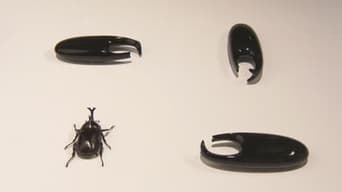DESIGN TALKS plus Season 5

What is good design? And what is its power? From traditional to cutting edge, we explore Japanese designs that are literally shaping our lives.
Watch NowWith 30 Day Free Trial!
DESIGN TALKS plus
2015
What is good design? And what is its power? From traditional to cutting edge, we explore Japanese designs that are literally shaping our lives.
Watch Trailer
With 30 Day Free Trial!
DESIGN TALKS plus Season 5 Full Episode Guide
Concerns about health and sustainability mean that many people today are looking for new approaches to eating. Technology has led to exciting new developments in food. Fermentation plays a key role in Japanese cuisine leading to the diverse flavors of miso, tofu and pickles. Dashi stock is in the spotlight for its rich umami. Fermentation designer Hiraku Ogura is passionate about Japan's fermentation technology and history. Join him as he explains the art of eating through design!
Designs have long used optical illusions and tricks, but new creators are putting them front and center to educate and entertain. Kokichi Sugihara is a university professor and leading illusion researcher. Our presenters experience illusions, learn their mechanisms and explore their social potential!
Traditional crafts and manufacturing have a long and proud history in Japan. But lifestyle changes and a lack of successors mean that many who work in these traditions face grave challenges. Yet designers have fallen in love with the extraordinary work of these skilled artisans and have created updated designs to appeal to a new generation. Explore how traditional skills and materials are being kept alive through revolutionary young designs. Discover the future of tradition!
The development of new materials has played a key role in human evolution and economic growth. At the same time, it has often led to environmental issues, some of which are only now coming to light. Some are coming up with solutions through design, shaping new approaches to fashion, architecture, and everyday products. Join fashion designer Yuima Nakazato as he explores new materials, and the relationship between humanity and nature. Discover designs with a new vision for our future.
Around 70% of Japan is covered in forests. Japanese cedar is an indigenous species that's been used in everyday life for centuries. It's easy to work with and has a beautiful grain that's perfect for many designs. Cedars that grew to enormous size have even become objects of worship. However, falling demand means cedars are starting to destabilize forest environments and their pollen has become a major problem. Join designer Katsushi Nagumo as he explores new ways to bring the culture of Japanese cedars into the future.
On Design Hunting, Andy and Shaula search for designs rooted in regional history and climates. This time they visit Nagasaki Prefecture and its unique culture colored by trading with China, the Netherlands, and many other countries. Regional crafts from glassware influenced by European stained glass to 400-year-old ceramics are still alive today. Join us on a hunt for the cosmopolitan and always evolving designs of Nagasaki!
Green spaces have become all the rage and new and old Japanese designs are in the spotlight. A "mixed-planting unit" is designed to provide seasonality in an urban setting. It draws on the planting of Japanese gardens 400 years ago in its goal of greater greenery. A historic plant market in Asakusa is a centuries-old summer tradition. Landscape designer Michio Tase explores the ways Japanese incorporate plants into their everyday lives, and new potential green lifestyles.
The colors, textures, biology, and behavior of insects reveal a world far more diverse and extraordinary than we could ever have imagined. Insects had been evolving for tens of thousands of years before humanity ever emerged and they offer glimpses of amazing creative potential. A new exhibition on insects examines them from a design perspective. Its director is graphic designer Taku Satoh; join him on an exploration of the weird and wonderful and what that means for design.
Japan is one of the world's rainiest countries with a monsoon in June, fierce summer storms, and mellow autumn showers. Traditional homes evolved to cope with heavy rain and high humidity, using deep eaves, verandas, and rain screens. A culture developed that doesn't fight the rain, but keeps us dry enough to admire it. Architect Takeshi Hosaka explores designs that help us enjoy the rain.
Japan has a long history of forms and conventions that form the foundation of everything from martial arts to the tea ceremony and calligraphy. They're a deeply rooted part of the techniques and dedication required to master a craft. Creators in the design world are cherishing the heart of these traditional forms while also coming with new and original ways to express them. Architect and artist Fumihiko Sano explores these unconventional ideas and the philosophy behind them.
On Design Hunting, Andy and Shaula search for designs rooted in regional history and climates. This time they visit Hokkaido Prefecture. The indigenous Ainu have a deep respect for nature which is reflected in their traditional designs. The island's sweeping vistas are the product of landscape design, while wooden furniture from Asahikawa has won international attention. Explore the Hokkaido designs shaped by a harsh and snowy climate.
Japan's rural landscapes are changing as the population ebbs. Meanwhile cityscapes are also in flux during the lead up to the Tokyo 2020's big events. The views we see as part of our everyday lives can change in moments during natural disasters. Landscapes are deeply interwoven with human life and evolve alongside us. Civil engineering is a key factor in shaping them. Join studio guest and architect Hiroshi Naito as he explores landscape engineering in the city and the countryside.
Many people are discovering the pleasure of making what they need instead of relying on manufactured items and pre-existing services. The self-sufficiency of DIY has become a trend. As users turn from buying to making, professional creators are changing their own approach to design. Guest architect Jo Nagasaka explores the world of new designs inspired by DIY.
Today is part of our Tokyo Cityscapes series. Although new skyscrapers are constantly being built, work is also underway to make Tokyo a sustainable city. Buildings are surrounded by green, forests planted near communal housing, and the city is getting a re-design through plants. Landscape architect Tatsuya Hiraga, and gardener and landscape designer Michio Tase both explore the new cityscape of Tokyo as it evolves a new co-existence with plant life.
On Design Hunting, Andy and Shaula search for designs rooted in regional history and climates. This time they visit Niigata Prefecture, where clean water and mountains create rich soil that's the foundation for a food culture of rice and sake. The prefecture is home to Tsubame-Sanjo and other manufacturing towns. We also visit the Echigo-Tsumari Art Field which has grown into an international art festival. Explore a new perspective on Niigata's charms and on its designs!
The library: a silent temple of learning, with thousands of books lining its shelves. This traditional idea is starting to change. New spaces are coming forward that also provide community spaces, workshops, and places for people to meet. Book director Yoshitaka Haba explores new library designs and how books can create open spaces to attract visitors.
Social design provides a creative approach to issues of poverty, an aging population with fewer children, and many other social issues. The power of design can be leveraged to provide better social systems for everyone. Several projects are now pursuing this aspect of design's original role, helping to solve problems instead of pursuing profit. Design strategist Eisuke Tachikawa explores social design and its extraordinary future potential.
As technology evolves and we have more information available than ever before, our values are also diversifying. The social role of design is also changing fast. Art director Kashiwa Sato, Toshiyuki Inoko of teamLab, and architect Tsuyoshi Tane are among the designers and creators who have examined their approaches to design on the show: take another look at what we need from designs today!
Alarm clocks, phones, and car horns are all everyday sounds. We're surrounded by sounds that inform or influence our behavior. From stress-relieving music on hold to warning and alert sounds, even the sounds that we take for granted are designed with a clear intent in mind. Together with sound designer Takashi Kokubo, we explore how environment and purpose have led to a diverse and fascinating world of sound design.
On Design Hunting, Andy and Shaula search for designs rooted in regional history and climates. This time they visit Yamanashi Prefecture, home to many mountains including Mt. Fuji, the Yatsugatake range, and the Southern Alps. Many traditional crafts and industries rely on the resources from such peaks. From inden, a historic craft using deer leather and urushi lacquer, Japan's biggest producer of jewelry and jewelry design, to new umbrella designs that use textile technology. Explore how Yamanashi's deep-rooted traditions are creating designs for a new generation!
Japan is well known as a major player in the world of stationery! It's developed many creative and highly functional items, such as erasable pens. This time we go beyond function to explore the stationery that appeals to our emotions. Learn how stationery can provide entertainment and a hobby, becoming the focus of collections instead of mere tools. Guest Masayuki Takabatake is a stationery designer. He guides us through the world of stationery and design.
Plastic is a vital part of everyday modern life, used in everything, and found everywhere we look. But the environmental problems caused by micro plastics have made global headlines. Many designers are now using plastic to overcome our expectations of this material. Product Designer Keita Suzuki explores designs that examine the future of plastic.
The amazing variety of natural phenomena such as rain, clouds, rainbows, and light have long inspired creators. Fleeting shapes and astonishing beauty have appealed to many designers. Explore architecture, designs, and artwork that focus on such phenomena. Designer Haruka Misawa explores the potential of these new designs.
Andy and Shaula go design hunting, exploring the history and customs of the northern prefecture of Yamagata for new design discoveries. With 70% of the prefecture covered in thick forest, Yamagata has a long tradition of woodworking and wood-related crafts. The prefecture is also home to the Three Mountains of Dewa, where some of Japan's oldest mountain and nature-worshipping faiths originate. Explore Yamagata's untouched natural scenery and learn about the region's latest efforts to adapt traditional designs for a modern audience.
Free Trial Channels
Seasons


















































